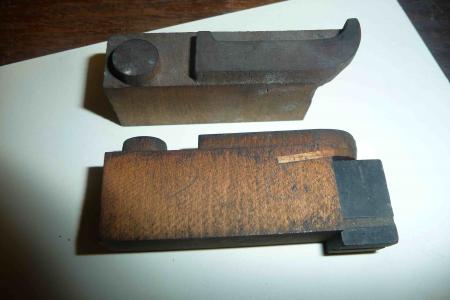Locking up wood type.
The attached image shows a Stephenson Blake lower case j. In trying to lock up the type in a form I’m finding my reglets and furniture (both wood and metal) are made to a depth deeper than this cut. A std 30pt quad placed under this descender illustrates the problem. You can also see that the insert supporting this j protrudes out at angle greater than 90 degrees. Any wise words out there on how to lock up and print such type?
Cheers
Matt

P1010876.jpg
When setting the line with this character, I would think you could use a piece of standard furniture lying on it’s side (unless you need another line of type closer than that would allow. You could also cut down either a quad (as you pictured) to the proper height to work under this character and use standard spacing under the remainder of the line.
If you don’t have a composition saw, the quad can be cut down with a hack saw.
I would cut the top off a period, then it would be the right height to fit under the j, or you could cut a couple of quads to the right height. Dick G.
One thing is that you don’t want the descender to break off. Someone made a saw cut into the letter at an angle and then glued a thin piece of side grain wood under the descender to try to support it. If the letter was used after that, it obviously worked because the descender didn’t break off. However, it still looks like it might break, so I would reinforce it some more.
You could cut a triangular wedge of hardwood and then glue it under the hanging descender with carpenters yellow wood glue. (Where the wedge is going to be glued, rough up the wood a little with sandpaper, or scratch it with a knife point, so the glue will grip the wood better). If you can’t cut the angles of the wedge exactly, put a lot of glue in to fill any openings between the letter and the wedge. The grain of the wedge should run the same way as the end grain of the type. The wedge should stop just above the bottom of the type. That way you won’t have to cut the wedge exactly to match type high, which would be hard to do.
When locking it up, put some furniture, reglets, etc., up to the wood wedge at the bottom, but don’t try to put anything in which would push hard on the wedge. (Put more spacing where the rest of the line is, to take the pressure). Pressure on the “j” with the wedge might make it work up during the run. Just make sure the “j” is pushed into alignment correctly before locking the form up tightly. The lockup pressure should hold it in place. Then keep an eye on it during the run. If you have trouble keeping it in place, you can always glue another wedge upside down from the original one, to make a perpendicular bottom side on the “j” so you can put lockup pressure against it, but I doubt if you will need to.
I’d suggest a different approach — find a precision printer’s cut-off saw and cut some special furniture the height of the space under the overhang (doesn’t need to actually support the overhang) and the width of the overhang. Use that furniture to space out the lines with the “j” in them (there must be other similar overhangs with other descender characters like “g”, “p”, “q”, and “y”). I bet the cut-in reinforcing was put there by the manufacturer. Unless you’re trying to print deep impression with your wood type I expect the “j” can take the pressure.
Bob
Thanks folks.
Bob; I agree, I believe the fount was delivered like this as other characters with descenders have the same tidy treatment.
Why? I thought perhaps it is about achieving tighter leading when no descenders are present but the shoulder of the sorts is not machined to a height that can accommodate the overlap of the descender? Where’s Mr Stephenson or Blake when you need them?
That aside I’m sure I’ll get a result, it’s only a very small run. I have a saw and can tinker with cutting out a support using either furniture or an old quad.
Again thanks,
Matt